Octopus Heat Pump Survey Results and Planning Permission

Welcome back to my heat pump journey. In the last article I went over the first steps I had taken and that included getting a baseline of my home’s energy efficiency, getting an energy performance certificate, and finally having a heat pump survey conducted by Octopus Energy. Well, I have the results of that survey back now and ready to show you! The surveyor told me it could take up to 14 working days for the results to be sent to me, but they actually sent them through the next day.
Survey Results
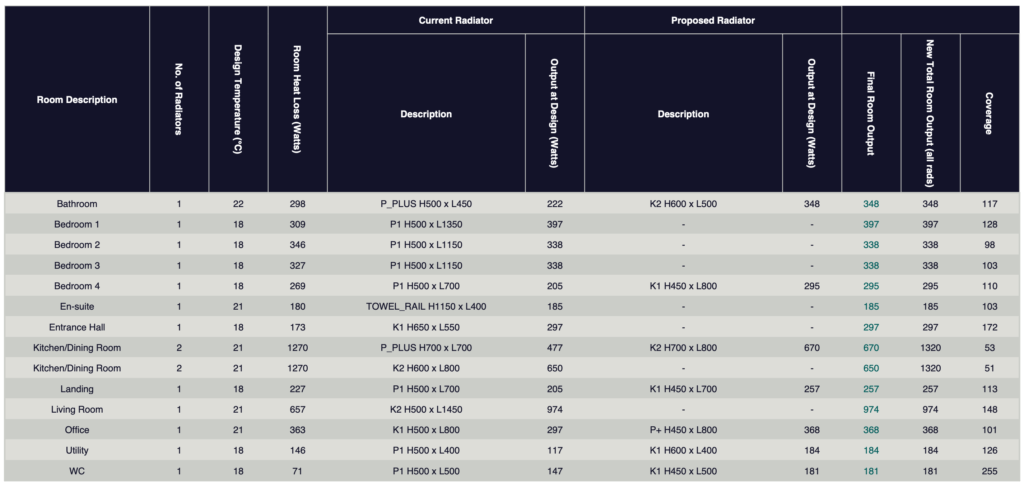

Here’s the breakdown of the room by room heat loss calculations. You can see that they’ve made assumptions on the required room temperatures with the bedrooms being 18 degrees and daytime or evening living areas at 21. They’ve decided that seven of my radiators need to be upgraded to slightly better ones. This does surprise me actually – I thought they’d need to replace more than that especially as the bedroom radiators are only P1 or type 10 radiators, those are the ones that are a single panel with no fins at the back, but as you can see the surveyor was happy with them – more on that in a minute!
They’re specifying a 6kW Daikin heat pump – they’d considered using the smallest 4kW model but my home is right on the upper limit of that heat pump if it were performing under ideal conditions, so a 6kW should still give me a decent SCOP without risking underperformance in extreme conditions. And for hot water, they’re putting in a 250 litre tank, which is massive compared to my current 140 litre tank but the MCS guidelines say that for a 4 bedroom house with a bathroom and an en-suite, you fit a 250 litre tank.
Now, this information is all very interesting, but how should I or anyone go about verifying if what they’re saying is accurate. Well, you should always get multiple quotes so as at the very least you can compare. But there’s also a rule of thumb!
Octopus Energy using my referral link:
speaktothegeek.co.uk/energy

The ‘Heat Pump Rule Of Thumb’
The Protons for Breakfast blog proposed that if you have a gas boiler, you should take your annual gas usage and divide it by 2900. Now, there are several articles on that blog which discuss where that figure of 2900 comes from, but for now let’s see what happens with my data.

Using my trusty Hildebrand Glow and Home Assistant I have been recording my gas usage for the past 12 months. You can see here that I used 6847 kWh of energy from gas over 12 months. If I divide that by 2900 I get a result of 2.36. So I’d need a heat pump with an output power of 2.36kW in order to heat my home. If you’re thinking “well that sounds ridiculously low” then you’d be right. The thing is, I’ve broken the formula!
Over the last couple of years I’ve spent a huge amount of time and effort reducing how much gas I’m using. I installed a Honeywell Evohome multi-room heating control system many years ago and that has given me the ability to fine tune exactly how we heat out home. Through monitoring and experimenting, I figured out the most efficient way to heat my home. For example, rather than just heat the rooms just in time for when I needed them warm, I’d actually warm all rooms at the same time. Then I’d set different rooms to reduce their set point at different times. One big effort to heat the whole house in one go used less energy than heating various rooms at different times. I guess the system must have overheads meaning getting a specific room up to temperature on its own is less efficient. I also reduced the set points to 19 or 20 degrees during the evenings, 16 degrees over night, and I stopped using gas to heat the hot water too. We’ve been running purely on Eddi boosts apart from the occasional full tank from the boiler for a bath or visitors. Oh, and a crafty little automation to turn off the heating if the doors are left open for more than 5 minutes – it’s difficult to measure how much energy that has saved me but it triggered several times a week!
So if my low usage broke the formula, what should I do? Well, the estimate from Octopus on how much gas I should be using for this size of house is 13,000 kWh. I don’t have any old bills or data that I can use but from memory of before I optimised everything, that value seems ballpark accurate. If I use 13,000 kWh and divide that by 2900 I get a value of 4.48kW. So a 4.48kW heat pump – this is sounding more like the logic from Octopus. They advised me that the 4kW heat pump could provide, under optimum conditions, up to 4.7kW. There’s not a lot of tolerance there so a 6kW heat pump has been specified instead. I think I’m quite happy with that sizing to be honest – it’s not massively over specified with a 9 or 11kW heat pump. I’m no expert in any of this, I must point out – I’m learning all of this as I go along so somebody is bound to point that it’s the wrong choice, and there’s going to be opinions in all directions!
HTC Estimator Spreadsheet
What was that you say? You want even more data?! Ok, go back over to the Protons for Breakfast blog and there’s a spreadsheet called HTC Estimator. This spreadsheet has loads of tabs so you’re best off working through the instructions on the associated blog post but I’m going to whizz through them here to show you quickly.
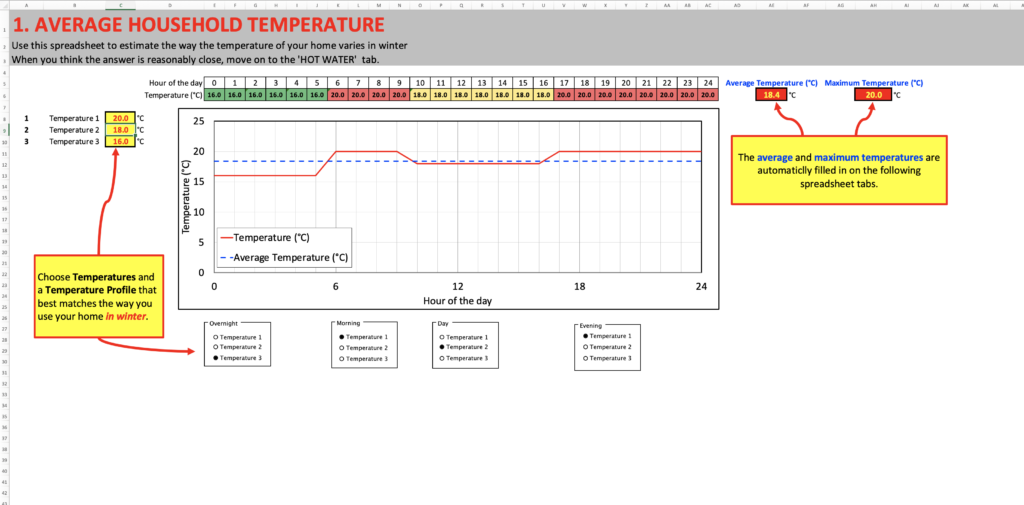

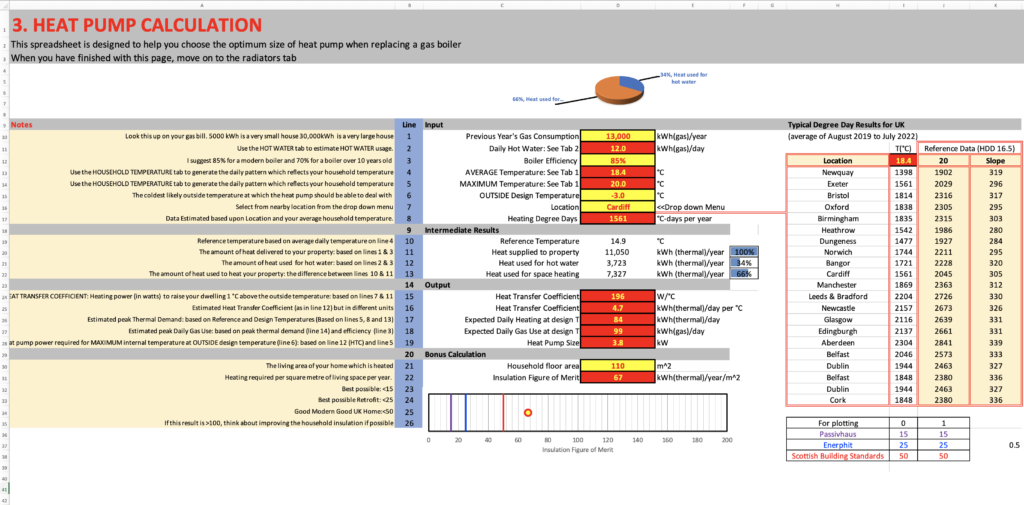
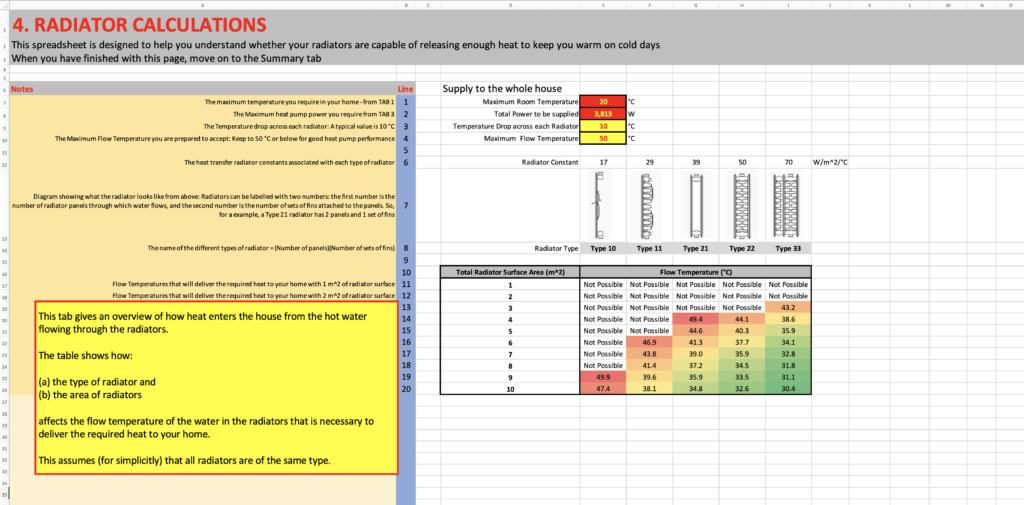
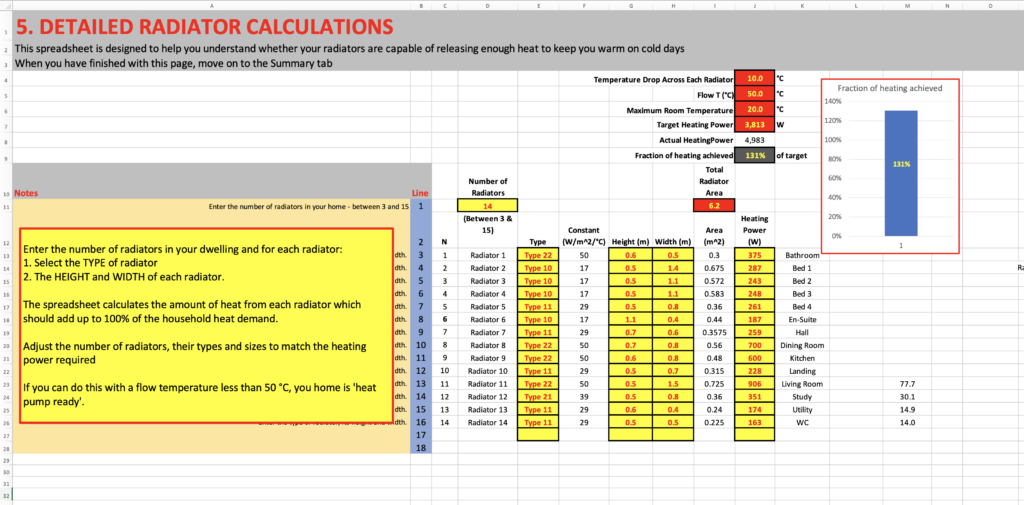

First tab, in this whole spreadsheet you only change values in the yellow fields. You set your desired temperature set points. I’ve said 18 degrees during the day, 20 in the morning and evening, then 16 degrees at night.
On the second tab for hot water I filled in how many people live in the house, which is 4, and let it guess at how much energy I’d need for that.
Third tab, I’ve stuck in the 13,000 kWh of full year gas usage in here, because basically my reading of 6847 really breaks things!
I left the boiler efficiency and outside design temperature alone, then chose my nearest location from the location dropdown. Finally I set the household floor area value.
You can already see though that it’s saying I need a heat pump size of 3.8kW so again, we’re in the 4kW ballpark.
Now we’re going to look at the radiators, and the fourth tab is where you set the temperature drop across each radiator and the maximum flow temperature you’d like to use. I’ve left it at the defaults with a 50 degree flow temperature.
And on the fifth tab I’ve defined all of the radiators – these here are the radiators as specified by Octopus with their changes, rather than the actual ones I have at the moment. What is interesting here are those output powers for bedrooms 1, 2 and 3. This spreadsheet has calculated the heating powers of those radiators and the values are 25-30% lower than the calculations from Octopus meaning that these three rooms have radiators with a lower power output than their heat loss. I’ll need to do some more research on this and find out why there is such a discrepancy between these values and the ones from the Octopus survey and I’ll get back to you on that one.
Well what does this show us then? It shows that the radiators as specified are sufficient to heat my home, achieving 131% of the actual target. It doesn’t actually tell me if it’s sufficient to heat each room which is a shame.
Finally the summary tab, you can fill in your energy rates on here and it’ll give you an idea of how much you’ll save or how much extra it’ll cost you to run this system, and it’ll estimate your reduction in CO2 emissions too. I will stick links to the spreadsheet down in the video’s description so as you can try this out for yourself.
Planning Permission
On to planning permission then. Why do I need planning permission when heat pumps are generally considered permitted development?
If we take a look at the planning permission guidance for Wales, I want to point out two things. Firstly, “no part of the air source heat pump can be installed within three metres of the boundary of your property”. The preferred location for my heat pump will place it 2.2m away from the boundary fence. Secondly, the paragraph right at the start about making sure that it “complies with the MCS Planning Standards (or equivalent standards)”. That part is quite crucial and something I didn’t fully understand to start with until I spoke to the Octopus team about it.



Basically in order to get the boiler upgrade grant, they must comply with MCS standards, and one of those requirements is that if there is line of sight between the heat pump and a neighbouring property’s windows then planning permission must be obtained.
The diagram above shows the location plan of my home with the boundary outlined in red. I’ve stuck a red block roughly where the heat pump will sit and you can see that although it’s a very shallow angle, it still has line of sight to the rear of my neighbour’s home.
So, planning permission is needed then. This was quite a daunting process to me having never been through a planning application before. I called up the local authority first to find out what they needed, then contacted Octopus for the information. A nice guy from Octopus actually sat with me, virtually on a screen share, and helped me with the application and provided me with all of the required information. I had to buy a plan for my property, and then put together a site plan showing the dimensions and locations of everything. This is the part I’m not totally confident about – I’m really not sure if I’ve done this correctly or not but I’ve tried to be as accurate as possible.
And that’s that, planning application submitted and it’s now a waiting game. I’m really hoping they reply soon to say it’s approved but I have a feeling that there’s going to be a bit of back and forth on this. I’ll update you on the progress when I have more news.


